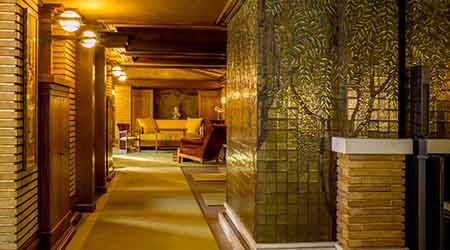 A comprehensive facilities management plan was created for Martin House in Buffalo, N.Y., following a $50 million restoration of the six-structure historic landmark, designed by Frank Lloyd Wright.
A comprehensive facilities management plan was created for Martin House in Buffalo, N.Y., following a $50 million restoration of the six-structure historic landmark, designed by Frank Lloyd Wright.Run The Building Like a Business: Steps 7-10 for Preserving Historic Landmarks
Keeping things organized — with scheduling software and a central repository for drawings — as well as regularly reviewing budget helps keep the building running like a business.
7. Use an Electronic Scheduler to Organize Events
Historic buildings have become a prestigious venue for local and regional events in their communities. Event scheduling is not only a profit center for the property, it is also an indicator to the public as to how well the property is managed by its caretakers and curators. Specific details of an event include not only the name of the organization, the date, and the time, but also the number of attendees, table configurations, A/V equipment needs, insurance requirements, catering details, and set up/ break down times. The use of a shared online calendar, tied to a site map locating the spaces to be used, is helpful. Work orders, which can be entered to schedule set up/ break down and equipment needed, become key tools to be utilized by the property managers and external event organizers that demonstrate and aid a well-run organization.
8. Centralize and Maintain Drawings, Books, and Records
One of the most important responsibilities of the facility management and maintenance staff at a historic, or any operating, property is to maintain an up-to-date, complete set of building construction documents. The building drawings will provide current and future managers of the facility with information about the building HVAC system, electrical system, roof and wall construction details, foundation design, and underground service location and details. As repairs, renovations and other changes are made to the building, these documents must be updated to reflect changes.
Other critical site information that becomes part of the books and records library of the property includes equipment operating manuals, building management system manuals, test and balance reports, system certifications, tests, inspections, and annual reports such as tests of sprinkler system, hydrants, security system, elevator, and backflow prevention.
Centralizing documents and creating electronic files of materials will simplify storage and use for management and maintenance staff. Most National Historic Buildings and Landmarks are public spaces which makes records management all the more important as stewards of a safe and well cared for facility.
9. Review the O&M Budget on a Monthly Basis and Reinvest the Surplus
An operations and maintenance budget includes all expenses such as utilities, on-site labor, building supplies, cleaning supplies, contracted services, and management and support costs. Capital projects that exceed a threshold value (say $2,500) are typically not included in on-going maintenance and operations budgets. The O&M Budget should be prepared by staff, and reviewed and approved by the board of directors on an annual basis. It is then up to the facility manager to operate the site within the approved budget. The budget results should reconciled and reviewed on a monthly basis with open discussions related to variances and ways to operate more efficiently.
The goal of a well-managed O&M budget is to identify surplus funds as quickly as possible that may be reallocated from ongoing O&M to much needed capital projects. This re-distribution of funds may be accomplished within the approved operating budget. It will benefit the facilities manager to maintain a list of small capital projects to be completed along with monthly review of the operating budget so that as funds are available, projects may be completed that will improve the aesthetics and overall public experience.
10. Run the Building Like a Business
Understanding the sources and uses of funds is one of the most important responsibilities of a not-for-profit executive organization in charge of a historic building or national landmark. A popular area landmark can generate significant revenues based on programs, events, and rental opportunities at the site and can bolster public interest and support. Between managing day-to-day operations, providing mission-driven programs, caretaking and property stewardship, it is the obligation of the executive director and board of directors to be fiscally responsible and run the institution like a successful business.
Related Topics:















